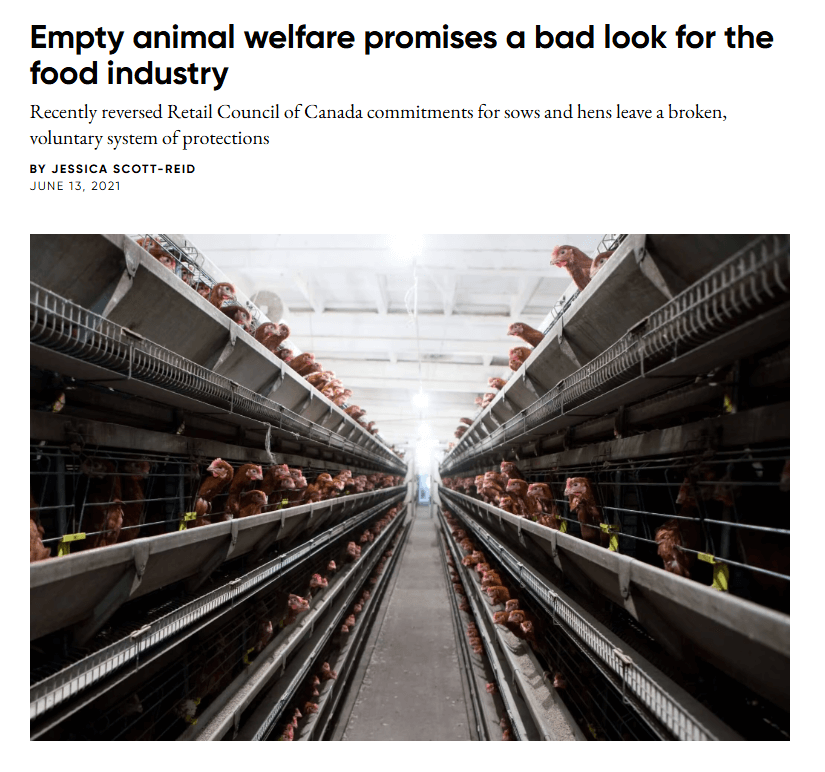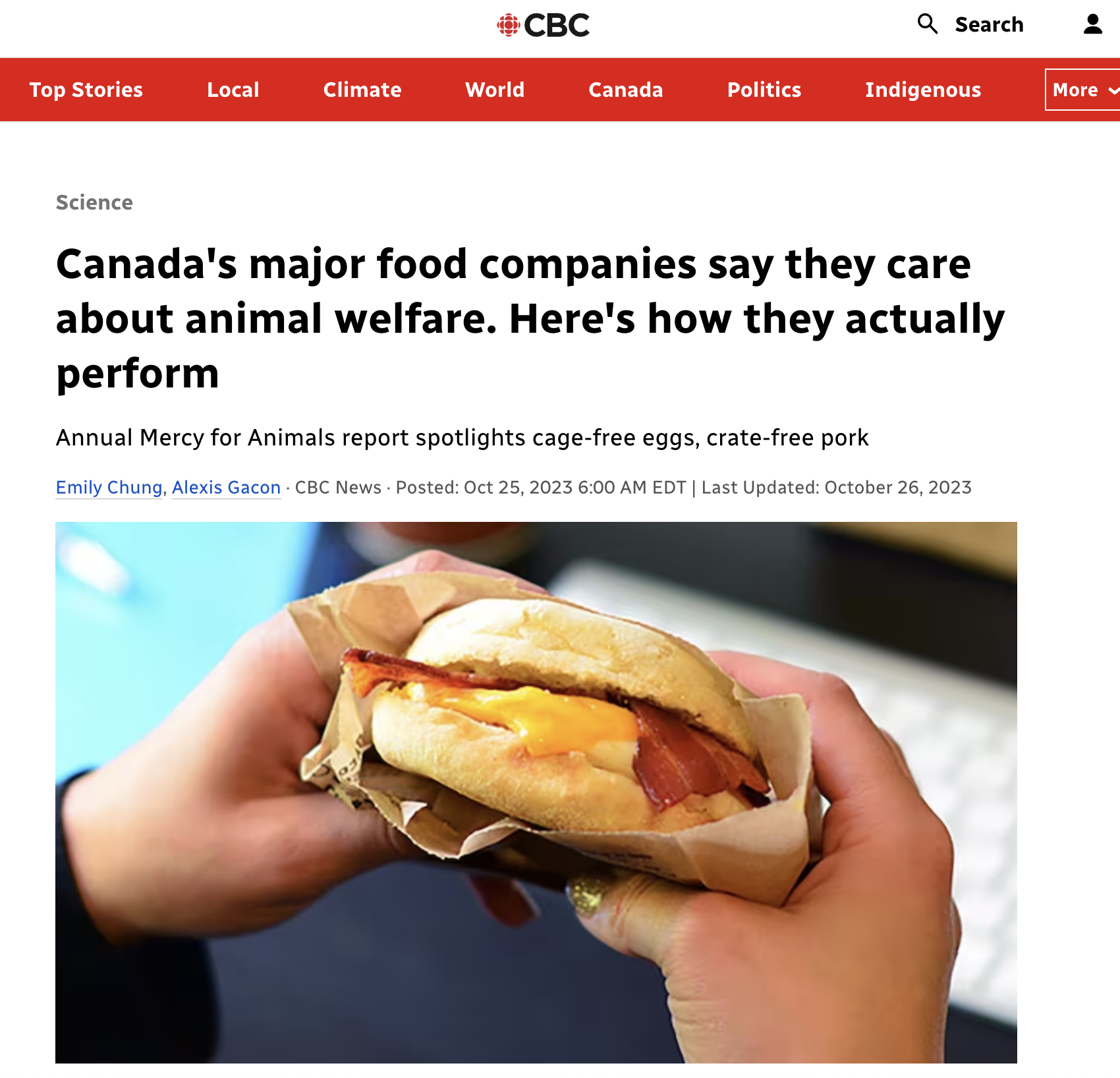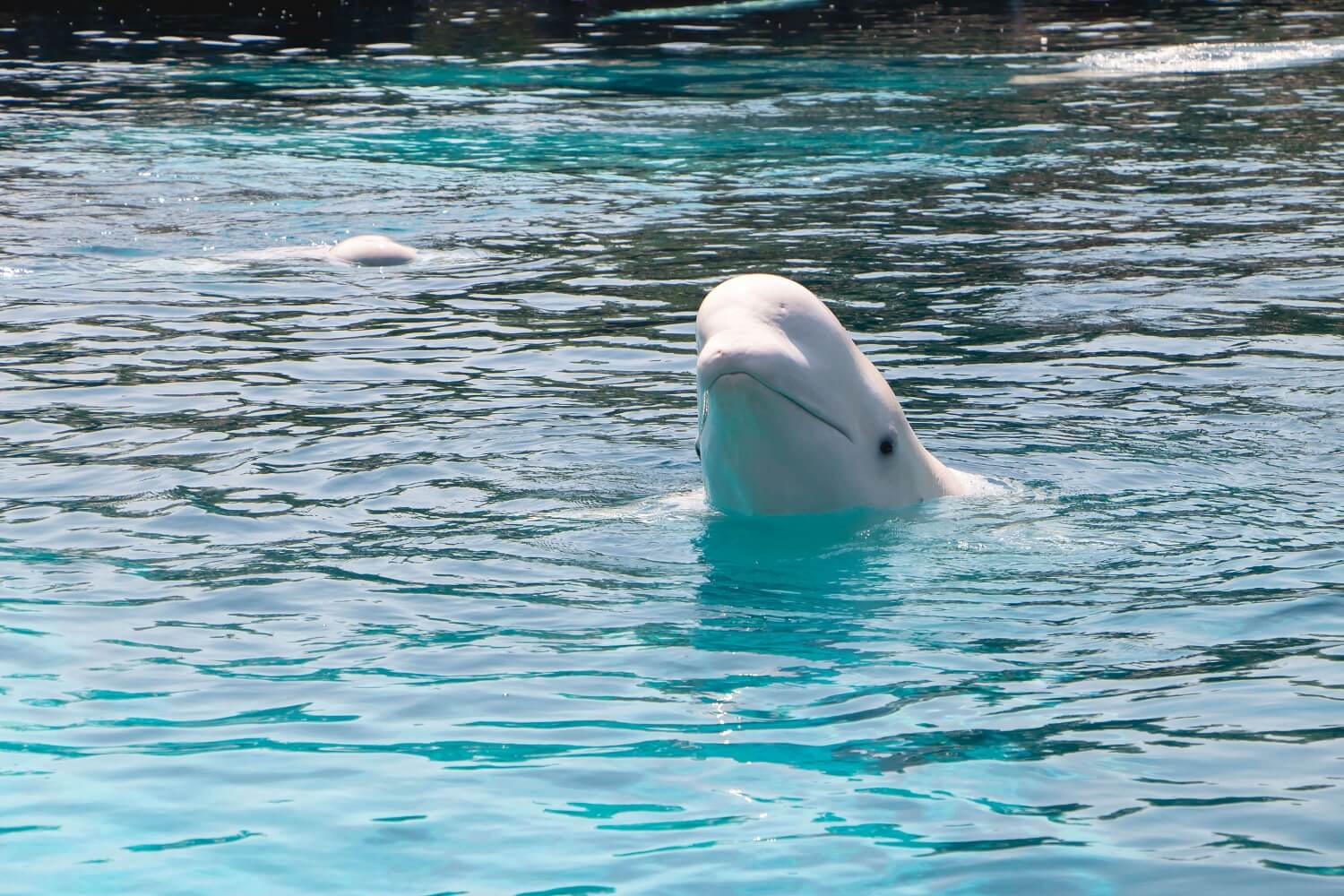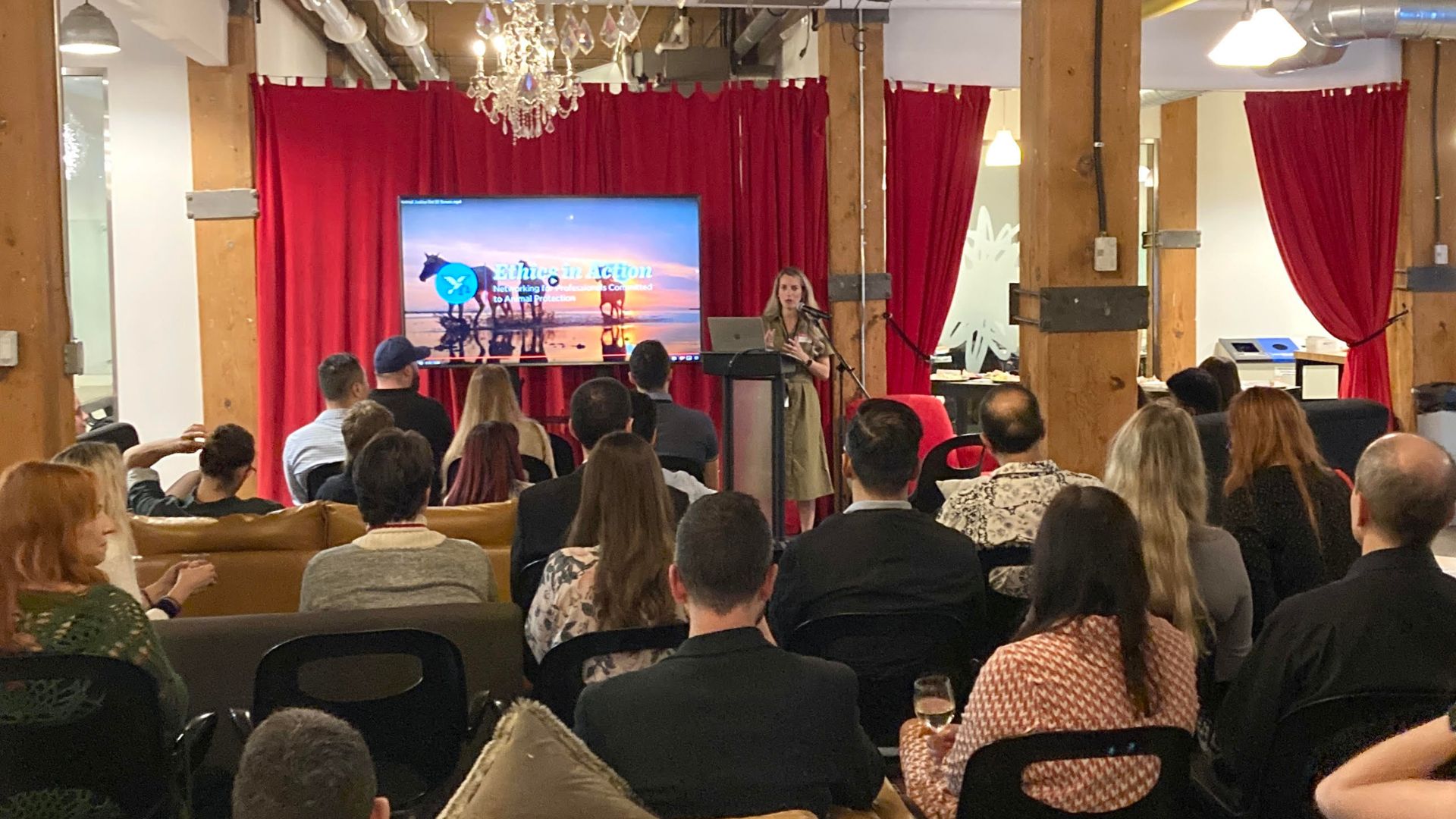In 2016, Canada’s largest grocery chains made a groundbreaking commitment: to finally stop selling eggs from hens confined in cruel cages by 2025. Following a wave of corporate cage-free policies around the globe, this was a sign that the country’s most powerful companies were listening to growing public outcry against one of the worst practices used on factory farms.
Things changed in 2021. Halfway to their policy deadline, the grocery sector took an unexpected turn in their approach to animal welfare. The Retail Council of Canada (RCC) backtracked in favour of following existing industry practices. Responding to public pressure, many grocery stores restated their cage-free commitments, but now with the caveat that they needed more than the remaining four years in their decade-long timeline to go cage-free.

Companies in Europe—and even the United States—invested in long-term plans to end the cage age. But the RCC took a different path. It chose to commit only to the existing, woefully inadequate standards set by the National Farm Animal Care Council (NFACC). This was a notable departure from supporting their members’ promises to consumers and investors. Misleading marketing called this “renewing focus on animal welfare,” but the truth is that the RCC led the country’s largest food companies to abandon commitments to ending extreme confinement for pigs in gestation crates and caged hens.
What has unfolded since is a remarkable case study of how Big Agriculture undermined the animal welfare policies of Canada’s leading food companies, setting the country on a path to fall behind on the world’s most recognized benchmark for farmed animal welfare.
Regulatory Capture: How Industry Self-Regulation Fails Animals & Undermines Corporate Responsibility
NFACC has been setting voluntary standards for on-farm practices in Canada since 2009. But even with these guidelines in place, countless undercover investigations have exposed the horrific reality behind barn doors. Sick and suffering animals endure life crammed into long rows of filthy cages. After a decade of egg industry exposés in the 2010s, the public stopped believing this cruelty only happened in the US. They began to see undeniable evidence of suffering happening right here at home.
As critics have long pointed out, NFACC’s codes of practice are flawed. They are “created by a group dominated by the very industries affected by those standards.” Imagine the fox guarding the henhouse. Instead of binding, government-enforced laws and regulations, NFACC produces voluntary “codes of practice.” These are developed by committees where most members financially benefit from large-scale, intensive factory farming. It’s hard to believe that committees packed with industry representatives would willingly create rules that hurt their profit margins or favour independent science that challenges their practices.
With NFACC dominated by those who profit from farming animals in poor conditions, it’s no wonder that NFACC codes are failing to provide good welfare. The grocery sector’s decision to hide behind NFACC and abandon their own cage-free promises perfectly illustrates this failure.
The Lowest Common Denominator: NFACC Stalls Progress Cage-Free Progress
NFACC is not a platform for progressive leadership on animal welfare. It’s an industry-controlled body that sets the lowest possible baseline for animals on farms. That baseline often lags behind Canada’s peers and what the public demands. The low bar set by producers across industries is precisely why corporate responsibility commitments exist. Every major grocery store—and over 100 other food companies in Canada—has a public cage-free egg policy. These policies are meant to surpass NFACC’s weak standards, which still permit the misery of caged hens in confinement.
NFACC absorbed progressive corporate responsibility policies into its producer-led process. In doing so, it essentially brought the movement to end cruel cages in Canada to a halt. What was supposed to be a private sector initiative, following the lead of both legislation and corporate policy in the UK, EU, and US, has been deliberately stalled—indefinitely. Our blog post on Canada’s lagging cage-free progress dives deeper into why we’ve fallen behind and what needs to change.
Importantly, grocery stores control a massive portion of Canada’s egg market—at least 60%. Yet, while restaurants, hospitality chains, campus cafeterias, and other food providers are going cage-free, grocery giants have barely moved in the last five years. This inaction flies in the face of overwhelming public support for banning cage confinement—a reform backed by people all over the world.

Imported Influence: Canadian Industry Embraces American PR Tactics
Canadian grocery stores were once on the same page as their international counterparts, making cage-free pledges a decade ago in response to public outrage. But the closer they have aligned themselves with the industry-dominated NFACC, the less progress we see for animals. Canada’s “animal care council” has played a direct role in reducing investment in animal welfare from companies who have had the support of their customers and investors to go cage-free.
A government-funded process was supposed to help coordinate private sector investment in animal welfare improvements. Instead, it has supported inaction by the country’s largest egg buyers.
So how are companies getting out of their commitments?
The Canadian retail sector and egg industry are doing more than hiding behind NFACC to evade accountability. They’ve also begun importing US-style PR tactics, echoing a familiar playbook seen during Big Tobacco’s decline. The RCC, and major players like Loblaws and Save-On-Foods, are new members of the Canadian Centre for Food Integrity—a PR front group for Big Ag with a US counterpart known for helping companies put a positive spin on animal welfare backtracking and other work to undermine the public interest.
Between coordinated PR efforts and increasing reliance on the industry-captured NFACC model, Canada’s grocery stores found a convenient way to avoid real action on animal welfare while acting like this is a good thing.
No More Leaders: NFACC Lets Grocers Sidestep Animal Welfare Commitments
Following the wave of cage-free commitments from over 100 major food companies in 2015-2016, NFACC did update its code for laying hens. However, the update only called for phasing out “conventional” battery cages—over the next 20 years, leaving a loophole where producers can claim they’re moving to alternative housing just by making cages a few square inches bigger and adding some decor. Animal Justice has documented shocking cruelty to hens in these new cage systems in our exposé.
NFACC’s updated code still considers “enriched” battery cages acceptable. This is despite a two-decade timeline unheard of in any other country phasing out cages. It also ignores strong cage-free legislation in the US and Europe. Scientific research continues to show that well-managed cage-free systems offer better welfare than any caged system.
What does that mean for companies with cage-free policies?
After the layer code update and the grocery stores’ cage-free pledges, Canada initially saw some progress, with cage-free production growing from 12 percent to 17 percent over two years. But since the major grocers’ decision to solely rely on NFACC, they have made zero new commitments and shown virtually no progress on ending cage confinement in their supply chains.

The grocery sector’s decision to “pursue and make commitments solely through NFACC” has led to no meaningful animal welfare commitments at all. It’s a clear win for the industry’s bottom line. But it’s a devastating loss for the millions of caged hens who continue to suffer. Worse, it comes with the apparent validation of Canada’s own “animal care” council.
Investing in Cruelty: Canada’s Misguided Egg Industry
Jurisdictions that have led the way on cage-free conversions have learned the hard way that “enriched” battery cages are a dead end. While more than 2,700 companies worldwide have adopted cage-free policies, Canada’s egg industry has taken a different path. For the past five years, it has enabled farmers to invest in slightly bigger battery cages instead. PR consultants help spin this as a progressive alternative to unwitting Canadians.
Meanwhile, around the globe, cages are increasingly understood as outdated and unsustainable due to public sentiment, welfare science, and a growing number of laws making cage confinement practices on farms illegal.
The Canadian egg industry’s short-sighted approach to invest in more cages even ignores its own guidelines, which admit that these enriched cages “do not fully support” the natural behaviors of chickens. Attempts to appease public, scientific, and legislative opposition to cruel cages by simply increasing their size have consistently failed. This approach ultimately burdens farmers, who face the cost of investing in housing upgrades twice.
Time for Leadership: Holding Corporations Accountable
Nine long years have passed since the grocery sector first promised to go 100 percent cage-free. Four years have passed since the RCC undermined a key corporate responsibility program of its grocery members. This situation reveals the danger of allowing industry interests to co-opt what should be a government-funded process to help the private sector improve animal welfare.
Major companies have the power and the responsibility to be leaders in animal welfare. Like any corporate responsibility program, by definition, standards will exceed what’s already happening. Otherwise, a pledge like “source 100 percent certified sustainable palm oil by 2025” would become “source palm oil”. In the case of animal welfare, companies like McDonald’s have managed to set and meet their own cage-free standards while also participating in industry-wide discussions through NFACC.
We should see NFACC establishing minimum guidelines, while also supporting and encouraging companies that commit to going above and beyond. Yet increased corporate involvement in NFACC has shifted the power dynamic in favour of producers. It has lowered animal welfare standards to the absolute minimum and discouraged companies from investing in real change.
The system is broken. Grocery retailers are failing to act independently and fulfill their cage-free commitments. By hiding behind NFACC, they’ve shown how industry interests have captured and stalled progress on farmed animal welfare.
Those who genuinely care about the welfare of farmed animals must take action. If we envision a future where millions of hens aren’t condemned to a lifetime in wire cages, we must hold these companies accountable. It’s time to demand a system that prioritizes animal welfare and the public good over private profits.
Banner: Existence | We Animals




